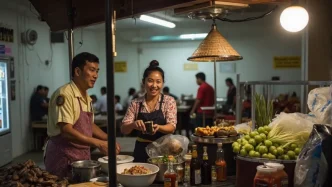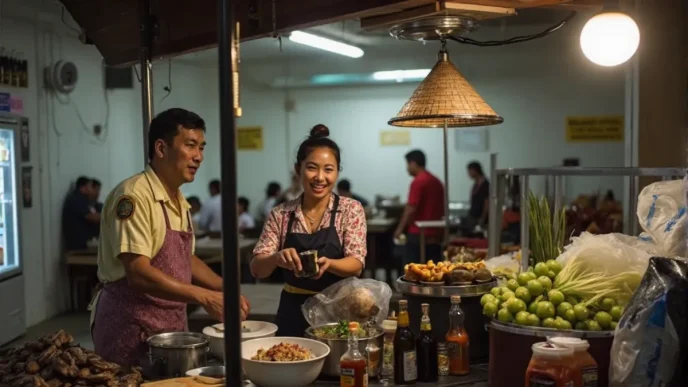In Ho Chi Minh City’s Thu Thiem district, 29-year-old Nguyen Thi Lan grips a tablet, practicing derivatives trading in a government-funded bootcamp, her eyes darting across market graphs. “HCMC’s building a financial hub, but it needs skilled people,” she says, dreaming of a career in Vietnam’s rising markets. Four hundred miles north, in Da Nang’s sunlit tech parks, 24-year-old Le Minh Duc codes a decentralized finance (DeFi) app in a buzzing startup hub, his screen alive with blockchain protocols. “Da Nang’s where crypto’s taking off,” he says, fueled by ambition. Vietnam’s vision to transform Ho Chi Minh City into an international financial centre by 2030 relies on Da Nang’s burgeoning blockchain expertise to power its digital economy. But with a 50,000-engineer shortage threatening Da Nang’s crypto future, can Vietnam train enough coders to lead Southeast Asia’s Web3 revolution?
HCMC’s Financial Ambition: A Supporting Stage
Ho Chi Minh City’s Thu Thiem Financial and Trade Zone, backed by a US$13.2 billion government investment, aims to redefine Vietnam’s economy by 2030, hosting banking, capital markets, and a digital asset exchange. The government’s Resolution No. 98/2023/QH15 commits US$7.2 billion over 2025-2030, including US$5 billion from a US$20 billion green transition public-private partnership, plus US$6 billion from retaining 50% of local taxes. This could create 120,000 high-skill jobs, adding US$12 billion annually to GDP and boosting Vietnam’s stock market from 44.7% to 120% of GDP. Yet, a 60,000-worker shortage in finance and tech looms, with only 5,000 professionals trained yearly.
The government’s US$100 million training fund targets traders and analysts, but brain drain—10,000 Vietnamese work in Singapore’s finance sector—slows progress. “HCMC’s hub needs Da Nang’s tech talent to succeed,” says Dr. Nguyen Thi Thu Ha, HCMC University of Economics. Da Nang’s blockchain prowess, from DeFi to stablecoins, complements HCMC, making it Vietnam’s crypto engine. On X, locals see synergy: “HCMC’s markets, Da Nang’s code—Vietnam’s unstoppable.”
Da Nang’s Blockchain Boom: Coding the Crypto Future
In Da Nang, Vietnam’s coastal tech hub, the Da Nang Blockchain Hub hosts over 300 startups, fueled by a US$60 million government fund for 2025-2030 to develop blockchain, Web3, and DeFi. The city’s role complements HCMC, with expertise in decentralized finance and stablecoin pilots, like USDT payments for tourism set for 2026. Le Minh Duc, coding his DeFi app, sees Da Nang as a rising star: “We’re building Web3 for Southeast Asia.” Yet, a 50,000-engineer shortage limits its potential, with only 1,000 DeFi developers active.
The government’s Digital Technology Industry Law, effective January 2026, offers tax breaks, R&D grants, and a regulatory sandbox for Da Nang’s blockchain experiments. Da Nang spends US$20 million annually to train 2,000 AI and blockchain engineers, targeting the 50,000-worker gap. The law’s workforce reforms integrate blockchain into university curricula, with five Da Nang institutions launching Web3 degrees in 2025. A government-backed pilot with Bybit tests a state trading platform, fostering DeFi skills. “Da Nang’s blockchain hub is Vietnam’s tech engine,” says Nguyen Anh Tuan, a Hanoi-based analyst.
DeFi and stablecoins are nascent but promising. Vietnam’s crypto legalization, formalized in 2025, supports USDT pilots, but Da Nang’s DeFi ecosystem, with US$200 million in locked value, trails Singapore’s US$2 billion. International settlements via stablecoins remain experimental, with no major projects in Da Nang, though startups like Duc’s explore cross-border payment protocols. The city’s strength lies in its developer community, ranking fifth globally for crypto adoption per Chainalysis, with 10% of its 1.1 million residents owning digital assets. On X, coders are optimistic: “Da Nang’s coding the future, but we need more devs.”
Challenges persist. Regulatory uncertainty, with Decree No. 94/2024/ND-CP pending, stalls DeFi growth. Only 10% of Da Nang’s startups focus on Web3, limited by infrastructure—like inconsistent power grids—and expertise. Singapore’s 5,000 DeFi developers dwarf Da Nang’s 1,000, and brain drain to Dubai’s crypto hubs, offering US$80,000 salaries, is a risk. The government’s sandbox, allowing controlled DeFi tests, is a step forward, but regulators lack Web3 expertise, with only 50 trained officials nationwide.
Building a Blockchain Workforce
Da Nang’s crypto ambitions hinge on overcoming its 50,000-engineer shortage. The city’s 300 startups demand coders skilled in Solidity, Rust, and smart contracts, but only 2,000 engineers graduate yearly, with 1,000 specializing in DeFi. The government’s US$20 million annual training budget funds coding academies, like the Da Nang Tech Institute, where Le Minh Duc honed his skills. “I learned blockchain here, but my class had just 30 students,” he says. Scaling to thousands is critical.
The Digital Technology Industry Law mandates Web3 education, with five universities—Da Nang University of Technology among them—launching degrees in 2025, aiming to train 5,000 coders by 2030. Partnerships with global firms, like Bybit and Binance, offer internships, with 500 students enrolled in 2025. Tax breaks for startups hiring local talent retain graduates, but salaries—US$15,000 versus Singapore’s US$50,000—drive 20% of coders abroad. On X, a student pleads: “Da Nang’s blockchain hub needs better pay to keep us.”
The government’s sandbox fosters hands-on learning, allowing startups to test DeFi protocols under supervision. A USDT tourism pilot, processing US$10 million in transactions by 2026, trains 200 developers in stablecoin systems. Yet, regulatory delays frustrate progress. Decree No. 94, expected in 2025, lacks clarity on DeFi taxation, stalling US$50 million in crypto investments. “We need rules to grow,” says Dr. Tran Van Nam, a Da Nang blockchain expert. Infrastructure gaps, like 5G coverage in only 60% of the city, hamper scalability.
DeFi and Stablecoins: Da Nang’s Niche
Da Nang’s DeFi ecosystem, though small, is vibrant. Its US$200 million in locked value supports lending and yield-farming platforms, with startups like Duc’s building apps for ASEAN markets. The USDT tourism pilot, backed by US$5 million from the US$60 million fund, aims to make Da Nang a crypto-friendly destination, processing hotel and tour payments. “Stablecoins could cut transaction costs by 30%,” says Nguyen Anh Tuan, envisioning regional adoption.
International settlements are a distant goal. While Singapore’s DBS Bank handles US$1 billion in blockchain-based trade, Da Nang’s pilots are experimental, with no major cross-border projects. Vietnam’s crypto legalization supports stablecoin growth, but Da Nang’s 1,000 DeFi developers limit scale. Chainalysis ranks Vietnam third globally for DeFi adoption, with 15% of Da Nang’s coders contributing to open-source protocols, a strength that could attract global firms. On X, optimism abounds: “Da Nang’s DeFi is small but scrappy.”
A Southeast Asian Crypto Race
Vietnam’s financial dreams, inspired by Dubai’s DIFC, rely on Da Nang’s blockchain hub to complement HCMC’s markets. Da Nang’s US$60 million fund and 300 startups aim to code a Web3 future, creating 20,000 tech jobs by 2030 and boosting Vietnam’s GDP by US$2 billion annually. HCMC’s US$13.2 billion hub, with 120,000 jobs, needs Da Nang’s coders to drive its digital exchange. Together, they could rival Bangkok’s tech scene and challenge Singapore’s US$2 billion DeFi market.
For Southeast Asian readers, Da Nang’s crypto boom is a call to action. Young coders in the city’s tech parks, building blockchain solutions like the USDT tourism payment pilot, embody the potential: “We’re creating a global digital economy,” says one developer at Super Vietnam 2025. Yet, the 50,000-engineer gap, regulatory haze, and brain drain threaten progress. Vietnam’s financial dreams, inspired by Dubai’s DIFC, rely on Da Nang’s blockchain hub to complement HCMC’s markets. Da Nang’s US$60 million fund and 300 startups aim to code a Web3 future, creating 20,000 tech jobs by 2030 and boosting Vietnam’s GDP by US$2 billion annually. HCMC’s US$13.2 billion hub, with 120,000 jobs, needs Da Nang’s coders to drive its digital exchange. Together, they could rival Bangkok’s tech scene and challenge Singapore’s US$2 billion DeFi market. Public sentiment on X reflects hope and urgency: “Da Nang’s our crypto future, but we need skills fast.” Vietnam’s 7% GDP growth and tech-savvy youth—65% of Da Nang’s residents are under 35—offer promise. Can Da Nang code its crypto dream, or will the skills shortage dim Vietnam’s blockchain star?
















